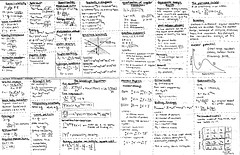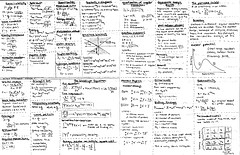HSC Chemistry and Physics Syllabus Dot-Point Notes

It is easy to understand the way the HSC is structured is in terms of syllabus dot-points. The syllabus, have a role of HSC trials and final HSC exams approach to play, as a consequence prove helpful for HSC students.
Structure of the HSC syllabus
For HSC sciences like Chemistry and Physics, the syllabus is a very useful study tool that students should use in preparing for their exams. Exams for these subjects MUST only contain questions that test knowledge within the bounds of the syllabus – that’s how our NSW HSC works.
Each ‘dot-point’ is a requirement for HSC students to understand a certain point, concept or issue. Together, these dot-points form the content of the entire subject. However the beauty of the syllabus is the way it is broken down into separate points, allowing students to study them individually, making sure each dot-point is understood.
Cover ALL the dot-points
Because HSC exams (and school internal exams) must only test knowledge contained within the syllabus, studying all the dot-points is a pretty safe and comprehensive study strategy if done correctly.
It is a good idea for all students to make their own syllabus dot-point summary notes nearing the end of the year in preparation for their exams. This reinforces their knowledge of the dot-points, and highlights areas of weakness in their knowledge. Sometimes, only when you need to write about a certain concept do you realise you don’t quite fully understand the concept.
Understand the connections between dot-points
It is important to note that syllabus dot-points should not be looked at in isolation. Most dot-points are in some way connected to other dot-points. For example, they may be dealing with aspects of a larger concept, topic or issue, or they may describe a larger concept or issue together, therefore they should not be looked at in isolation.
A good example is shown here:
2. Chemical processes in industry require monitoring and management to maximise production
Students learn to:
Identify and describe the industrial uses of ammonia
Identify that ammonia can be synthesised from its component gases, nitrogen and hydrogen
Described that synthesis of ammonia occurs as a reversible reaction that will reach equilibrium
Identify the reaction of hydrogen with nitrogen as exothermic
Explain why the rate of reaction is increased by higher temperature
The first 5 dot-points of this second section found in Chemical Monitoring and Management all deal with describing ammonia, its basic structure and the chemical reactions that are associated with it. When studying, students need to check that they understand each dot-point individually, as well as the bigger picture these dot-points highlight, in terms of fully understanding the general properties of ammonia.
Experiment dot-points
The syllabus also requires students to conduct “first-hand investigations”, or “gather secondary information” to find out more about a particular topic. Where these dot-points relate to experiments / practicals conducted in your school lab during class, HSC exams can and often do ask questions concerning the major aspects of these experiments / practicals.
Therefore it is highly important to pay attention to what is going on during one of these experiments / practicals.
Of particular relevance to HSC exams, students should always note the following three things:
1. What was the basic procedure followed, including equipment used?
2. What were possible sources of error (if relevant)
3. What were the risks to safety, and what precautionary measures were taken? (e.g. the need for safety goggles, gloves, tongs etc)
For experiments / practicals that are a syllabus requirement, HSC exam questions often ask students to discuss one or more of the points listed above. For example, a common one may be ‘Outline the procedure you followed to demonstrate the production of an ester” or “Account for the use of a fractional distillation column in your procedure to produce an ester.”
Therefore in your study of the syllabus, it is important to not neglect the “first hand investigation” dot-points, as they may very likely come up as a question in your exams!
George Li is a senior tutor at Dux College. George joined our education team in 2005 and has had years teaching HSC Chemistry and Physics at Dux College as well as outside of our organisation. George achieved a UAI of 99.95 in 2004, and ranked in Chemistry, Physics and Maths Extension 2. In terms of motivational techniques and good study habits, George is an avid promoter of best practice when it comes to preparation for the HSC.
Find More Physics Articles
